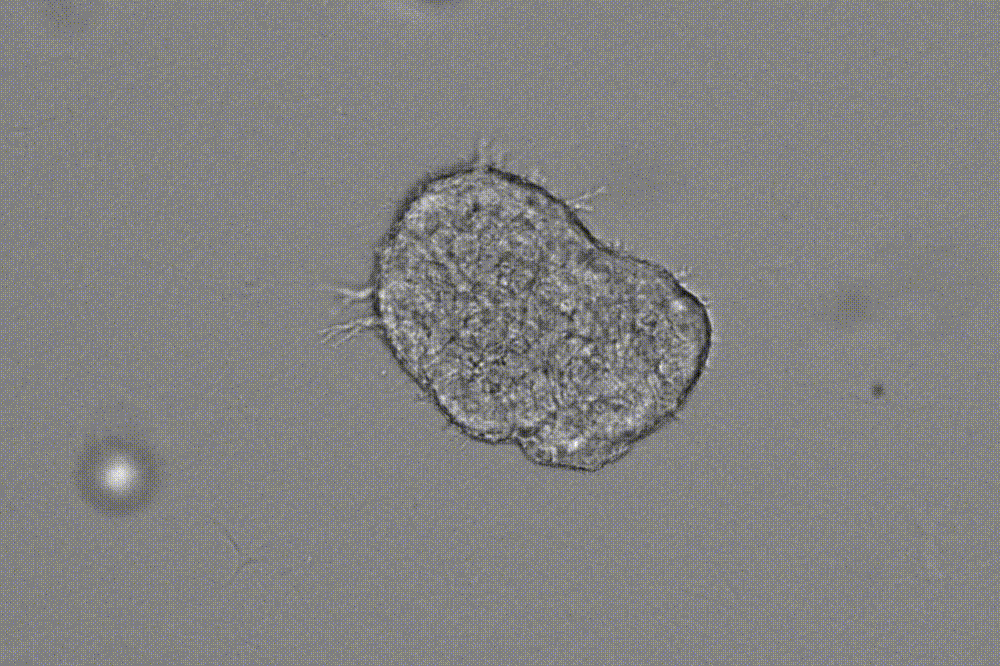
A breast cancer cell spheroid cultured in the presence of primary sensory neurons.
Cancer doesn't grow in a vacuum-each tumor grows in a particular microenvironment within the body and spreads through a tangled web of vasculature and nerves. Scientists have come to understand that the most potent therapies address cancer in context-accounting for both the tumor and the support structure that forms around it.
Now, a new paper in Nature reveals that the activation of sensory nerves within breast tumors is playing a critical role in promoting not only cancer growth but also its spread, known as metastasis. The findings-that sensory neurons are secreting a neuropeptide that drives cancer growth and spread through a previously unknown neuro-cancer crosstalk-suggest that targeting this pathway may help stop breast cancer progression in its tracks. The study also determined that an FDA-approved drug commonly used to treat nausea may prevent metastasis in these instances.
"Hyperactivation of neurons has been observed for tumors growing in the brain, but this is the first time we've seen it in an epithelial tumor such as breast cancer," says Veena Padmanaban, a postdoctoral fellow in Sohail Tavazoie's lab and lead author of the study. "This is an exciting discovery-no one has seen peripheral nerves release a signal to enhance metastasis before."
Getting on cancer's nerves
Scientists have long known a relationship exists between cancer cells and the nervous system. Solid tumors secrete proteins that recruit nerves to the primary tumor site. Nerve cell markers have been detected in cancers of the head and neck, breast, cervix, esophagus, colorectum, and pancreas, and studies suggest that the nerves of the autonomic nervous system, which regulates involuntary processes such as heart rate and blood pressure, can help kickstart prostate and stomach tumors.
Whether the nervous system promoted the metastatic progression of breast cancer-the most common cancer worldwide-remained a mystery. But it seemed plausible. Healthy breast tissue is full of sensory nerves, and evidence of breast tumor innervation existed in the literature.
"We had evidence that innervation was associated with worse outcomes in breast cancer," says Tavazoie, the Leon Hess Professor at Rockefeller. "And when we finally looked at breast cancer tumors, we discovered that highly metastatic tumors had recruited much more sensory innervation."
With this observation in mind, the team used mouse models to compare innervation between highly metastatic and less metastatic tumors. They then cultured cancer cells alongside sensory neurons to study their effects on breast cancer cells in vitro, analyzed publicly available data to correlate nerve markers with metastatic recurrence in breast cancer patients, and then removed sensory nerves within breast tumors.
The results demonstrated that innervation drives metastasis. "We found that the nerves not only promote the growth of breast cancer cells-they also help cells metastasize and break into tissues better," Tavazoie says. This alone was a key finding, because of the outsized role metastatic disease plays in cancer outcomes. "Metastasis is the main cause of death for most cancers-patients are dying because cancer spreads to distant organs," Padamanaban says. "Finding a way to stop metastatic disease is one of the greatest biomedical challenges of our time."
The neuro-cancer axis
As the team delved deeper, a more complete picture began to form. The researchers found that the enhanced innervation observed in aggressive tumors was driven by expression of the SLIT2 gene within the tumor vasculature, which encodes a protein involved in guiding the growth of axons to establish neural connections. They determined that once the nerves enter the tumors, they begin to secrete a neuropeptide called substance P that promotes tumor growth and metastasis by interacting with the cancer cell receptor TACR1. They also found that this interaction causes some cancer cells to die and release single stranded RNAs, which bind RNA sensing receptors on cancer cells to activate pro-metastatic genes that drive the rest of the cells forward.
"It had been reported that nerves can physically interact with certain cancer cells and directly influence them, but we observed a neuropeptide signaling mechanism, in which the nerves are releasing a neurotransmitter signal that diffuses to the breast cancer cells," Padmanaban says. "We're also seeing that that the neuropeptide acts on the cancer cells directly to activate an RNA signaling response, whereby the release of single stranded RNAs acts on nearby cells to activate a set of genes. That was unexpected and may have relevance that extends beyond cancer."
The findings have strong clinical implications. Publicly available data suggests that elevated levels of the neuropeptide that promotes metastasis and gene signatures associated with this neuropeptide and ssRNA are all linked to increased metastasis and lower survival rates in breast cancer patients. And the team managed to impede the growth and metastasis of multiple models of breast cancer when they treated mice with aprepitant, an FDA-approved TACR1 antagonist normally given to chemotherapy patients to prevent nausea.
"Because aprepitant is already approved and safe, oncologists may consider clinical trials to test the impact of this medication on cancer progression in patients with breast cancer," Tavazoie says.
Even if aprepitant doesn't offer the most effective treatment, the study gives researchers new therapeutic targets and opens the door to targeted therapies. "Our work may help bridge the fields of cancer metastasis biology and neuroscience, encouraging cancer biologists and neuroscientists to work together and bring each field's tools to the table."






